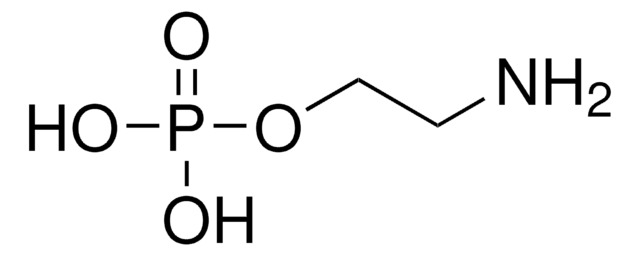E6133
Ethanolamine hydrochloride
≥99.0%
Sinonimo/i:
mea hydrochloride, monoethanolamine hydrochloride, 2-Aminoethanol hydrochloride
About This Item
Prodotti consigliati
Livello qualitativo
Saggio
≥99.0%
Stato
powder or crystals
Condizioni di stoccaggio
dry at room temperature
tecniche
HPLC: suitable
Colore
white
pH
9—10
pKa (25 °C)
9.5
Punto di fusione
82-84 °C (lit.)
Solubilità
water: 0.33 g/mL, clear, colorless to very faintly yellow
Densità
1.07 g/cm3 at 20—25 °C
1.12 g/cm3 at 20—25 °C
Compatibilità
suitable for chromatography
applicazioni
general analytical
life science and biopharma
pharmaceutical
Stringa SMILE
NCCO.[H]Cl
InChI
1S/C2H7NO.ClH/c3-1-2-4;/h4H,1-3H2;1H
PMUNIMVZCACZBB-UHFFFAOYSA-N
Cerchi prodotti simili? Visita Guida al confronto tra prodotti
Categorie correlate
Descrizione generale
Applicazioni
- in overnight incubation of the tips to attach primary amine groups at the tip surface
- in the preparation of DMEM (dulbecco′s modified eagle′s medium)/F-12 media to culture human epidermal growth factor receptor 2 (HER2) cells derived from MMTV-HER2 transgenic mouse mammary tumors
- to administer the cultures to study its effect on the endogenous phosphatidyl ethanolamine pool and autophagy process
- in a study as a reagent to study molecular interactions and adhesion forces in biological systems using Atomic Force Microscopy
- to prepare the reagent for surface-enhanced laser desorption ionization analysis, aimed at studying the role of Interleukins
Azioni biochim/fisiol
Caratteristiche e vantaggi
- Suitable for Immunology, Cellular Biology and Biochemical Research
- Tested to confirm low levels of heavy metal contamination, ensuring suitability for various applications
- Effective Buffering Agent with a pKa of 9.5 (25 °C)
Altre note
Prodotto comparabile
Avvertenze
Warning
Indicazioni di pericolo
Classi di pericolo
Acute Tox. 4 Dermal - Acute Tox. 4 Inhalation - Acute Tox. 4 Oral - Aquatic Chronic 3 - Eye Irrit. 2 - Skin Irrit. 2 - STOT SE 3
Organi bersaglio
Respiratory system
Codice della classe di stoccaggio
11 - Combustible Solids
Classe di pericolosità dell'acqua (WGK)
WGK 1
Punto d’infiammabilità (°F)
Not applicable
Punto d’infiammabilità (°C)
Not applicable
Dispositivi di protezione individuale
dust mask type N95 (US), Eyeshields, Gloves
Scegli una delle versioni più recenti:
Possiedi già questo prodotto?
I documenti relativi ai prodotti acquistati recentemente sono disponibili nell’Archivio dei documenti.
I clienti hanno visto anche
Il team dei nostri ricercatori vanta grande esperienza in tutte le aree della ricerca quali Life Science, scienza dei materiali, sintesi chimica, cromatografia, discipline analitiche, ecc..
Contatta l'Assistenza Tecnica.




